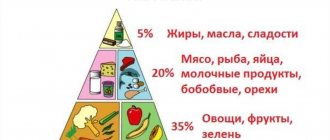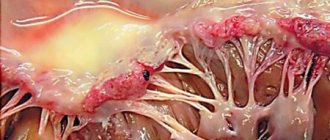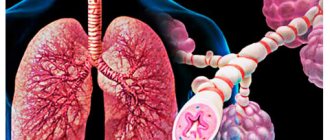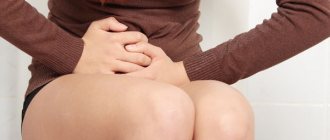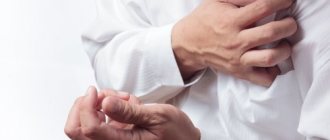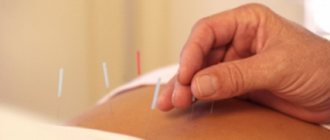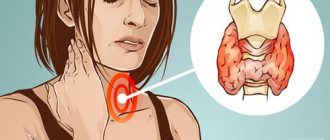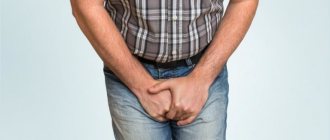Pain in the intestines
Intestinal pain is the most common complaint with intestinal diseases. It differs from pain in diseases of the stomach in that it has no connection with eating (an exception is the inflammatory process in the transverse colon, in which abdominal pain occurs after eating: pain in the intestines is associated with reflex contractions of the intestine when food enters the stomach).
Bowel pain is the most common complaint in bowel diseases
Pain in the intestines can be aching and cramping (intestinal colic). Colicky pain is characterized by short, repeated attacks. The aching pain is persistent and intensifies with strain from coughing. The pain is typical of inflammatory bowel disease. Pain in the intestines can occur as a result of distension of the intestines by gases during flatulence, intestinal obstruction (with tumors, volvulus, nodule formation). Such pains, unlike spastic ones, are more constant and aching in nature.
Often with intestinal obstruction, pain due to stretching is accompanied by severe cramping pain associated with increased intestinal peristalsis above the site of the obstruction. With the development of an adhesive process between the loops of the intestine, the pain is nagging in nature, intensifies when lifting a load, depends on the position of the body, and is provoked by an enema.
The localization of pain in intestinal diseases depends on which part of the intestine is affected:
- in diseases of the small intestine, pain is felt in the umbilical region, in acute appendicitis - in the right half of the abdomen, first appearing in the stomach and after a few hours going down.;
- with appendicular colic, pain may radiate to the right leg;
- pain in the right iliac region (the area of the wing of the ilium on the right) occurs with appendicitis, intestinal cancer, inflammation of the intestine (typhlitis);
- in patients with dysentery, intestinal obstruction , inflammation of the sigmoid colon, ulcerative colitis, cancer of the sigmoid and descending colon, pain is noted in the left iliac region;
- with acute damage to the left parts of the colon (dysentery), pain radiates to the sacral region;
- with lesions of the rectum (hemorrhoids, anal fissure, cancer, proctitis - inflammation of the rectum), pain is localized in the perineum, intensifying during the act of defecation, accompanied by a painful false urge to defecate (tenesmus);
- the appearance of pain before defecation is associated with disease of the colon, sigmoid colon, during defecation - with hemorrhoids, anal fissures, cancer;
- pain in the navel area is observed with inflammation of the small intestine (enteritis), inflammation and cancer of the colon;
- with intestinal obstruction, colicky pain is combined with constant pain. They are characterized by a certain localization (navel or colon area) and intensification due to intestinal peristalsis;
- Pain from intestinal damage can radiate to the chest and be mistaken for angina attacks.
Diagnostics
You can identify the cause of the pathology that causes pain in the lower right part of the abdomen by conducting an accurate examination:
- CT or MRI will show the condition of the internal organs and spine;
- Ultrasound – prescribed as an alternative for examining internal organs;
- Endoscopy will help identify diseases of the duodenum and biliary system;
- biochemical blood test, urine test - helps confirm damage to the liver, kidneys and pancreas.
Causes of intestinal pain
An unpleasant feature of pain in the intestines is that they (unlike pain in the stomach) have practically nothing to do with the timing of meals. In some cases, this fact can confuse a person, since the intestines sometimes hurt quite severely, and attacks happen extremely unexpectedly.
The only exceptions are disturbances in the functioning of the transverse section of the colon - in this case, pain appears immediately after eating due to an increase in the barometric load that comes from the bottom of the stomach. It is much worse when the cause of such pain is various (and sometimes quite serious) diseases.
The first thing that indicates a disruption in the functioning of the intestines is abdominal pain and abnormal bowel movements. You may experience flatulence or blood in your stool. With diseases in the abdominal cavity, appetite disappears and the person sharply loses weight. Food may not move well through the gastrointestinal tract, leading to cramping. Nausea and vomiting appear. The pain is localized in the affected part of the intestine. Disease of the small intestine is characterized by nagging, aching pain in the navel area.
If there are defects in the functioning of the large intestine, dull bursting pain is felt in the side. The pain is always antispasmodic in nature, that is, it is not constant. There are often cases when, due to intestinal disease, the patient has a fever and a feeling of fatigue. If you experience these symptoms, you should consult a doctor. Today medicine can cure almost any intestinal disease. And in the early stages this will be even easier.
Gynecological pathology
If a woman is brought to a hospital emergency room with abdominal pain, she must be examined by a gynecologist. This happens because without a specific examination it is difficult to exclude pathology of this kind. Diseases that result in pain in the right side are most often acute.
Ovarian apoplexy
Otherwise it can be called a heart attack or hematoma; popularly this condition is called “rupture”. Most often, the tissue of the right ovary breaks through, since the artery supplying it with blood is larger and comes directly from the aorta, and accordingly, the pressure in it is higher. Apoplexy occurs when there are pathological changes in the walls of blood vessels due to their excessive expansion and blood filling.
Ovarian apoplexy
Background diseases:
- polycystic ovary syndrome;
- varicose veins;
- inflammatory processes in the pelvis;
- abortion;
- drug stimulation of ovulatory processes (used in in vitro fertilization - IVF method, as well as in the treatment of certain hormonal disorders);
- disorders of the neuroendocrine system.
Trigger factors:
- a blow to the stomach or other injury;
- intense physical activity, especially heavy lifting;
- horse riding;
- excessively intense sexual intercourse.
Severe pain in the lower abdomen
However, the disease can develop without the influence of these factors.
Table. The main manifestations of apoplexy.
| Symptom | Characteristic |
| Pain | Sharp, sharp, intense. Appears in the lower abdomen on the right (when the right ovary ruptures), and can spread to the navel, lower back, and thighs. It can be either constant or paroxysmal. |
| Bleeding | Low blood pressure, weakness, pallor, lethargy, cold clammy sweat, increased heart rate, dry mucous membranes, chills, urge to defecate, vaginal discharge mixed with blood |
| Peritoneal phenomena | Tension of the abdominal muscles that cannot be overcome spontaneously, a flat, plank-shaped abdomen, sharp pain when touched. |
| Other | Nausea and vomiting, syncope (fainting), bloating, collapsing conditions |
Torsion of the pedicle of an ovarian cyst
A cyst is a “sac” filled with fluid. There can be anything inside the cyst: serous fluid, blood, pus, etc. The pedicle of the cyst is a formation that is in contact with the organ itself - the mesentery of the ovary, ligamentous apparatus, nerve fibers, vessels (both blood and lymphatic). When, as a result of sudden movements, increased intra-abdominal pressure (due to constipation, for example), pregnancy or weakness of the abdominal muscles, the cyst becomes twisted, all these formations become compressed.
Difference between a normal ovary and an ovary with a cyst
The pathology manifests itself as sharp pain in the lower right, nausea and vomiting, and abnormal stool. Requires surgical assistance.
Ovarian cyst rupture
Most often, functional cysts rupture - those that exist normally as part of the ovulatory process. External causes of rupture, by and large, correspond to trigger factors for rupture of the ovary itself. Symptoms:
- severe unilateral pain in the lower abdomen on the side;
- sharp tension in the abdominal muscles;
- nausea, vomiting;
- urge to defecate.
Emergency surgical treatment.
Ovarian cyst rupture
Ectopic pregnancy
One of the most dangerous conditions in gynecology. Develops as a result of disruption of the movement of a fertilized egg through the fallopian tube. Implantation (introduction) of the zygote does not occur in the uterus, as expected, but in the fallopian (uterine) tube, ovary, or even intestines. At first, this condition occurs without specific symptoms, and the woman’s condition corresponds to the early stages of pregnancy. However, when the embryo begins to develop and increase in size in an organ that is not designed for this, a serious problem arises. The fallopian tube or intestines may still dilate to some extent, while the ovary ruptures almost immediately.
Ectopic pregnancy
At the moment of critical expansion of the organ, the following symptoms appear:
- intense, sharp, sharp pain in one side of the abdomen;
- weakness;
- nausea, vomiting.
When the integrity of the organ wall is compromised, symptoms of bleeding appear. Treatment is only surgical; termination of pregnancy is necessary.
Salpingitis + oophoritis = adnexitis
Salpingitis is an inflammatory process in one or both fallopian tubes. Oophoritis is an inflammation of the ovary. Adnexitis is inflammatory changes in both organs. Since in most cases adnexitis develops, and not isolated inflammation, and it is almost impossible to clinically distinguish the symptoms of these diseases, it makes sense to consider them all at the same time.
Inflammation of the fallopian tubes
The pathology is caused by microorganisms that can enter the reproductive system in several ways: with the bloodstream, with the lymph flow, from underlying organs (vagina, uterus), and also from the intestines in a descending way. Inflammation usually begins in the fallopian tube, when the pathogen penetrates first into the mucous and then into the muscular layer. Later it enters the peritoneum, the epithelial cover of the ovary, and then into the internal part of the organ.
Symptoms:
- paroxysmal or constant aching pain in the right or left side of the abdomen, radiating to the sacrum and anus;
- temperature increase;
- chilling;
- disorders of urination and defecation;
- pathological discharge from the vagina (there is a lot of it, there is pus, and sometimes streaks of blood);
- muscle tension in the affected area.
Aching pain in the lower abdomen
Treatment consists of:
- ensuring complete peace;
- drinking plenty of fortifying liquids;
- taking antibiotics;
- anti-inflammatory therapy;
- adequate pain relief.
Physiotherapy can be used (after overcoming the acute phase). In the case of purulent inflammation, as a result of which the woman’s condition has worsened, surgical treatment methods are used.
Ovarian tumor
Neoplasms in the ovary, both benign and malignant, are unfortunately not uncommon. They are often combined with tumor lesions of the mammary glands and other organs of the female reproductive system. Tumors in the early stages usually do not hurt, but “give signals” in a later period of their development. Benign tumors can only appear as an incidental finding on a preventive ultrasound or with a significant increase in size. In this case, mild aching pain may develop in the lower lateral area of the abdomen. In the case of oncological processes, general symptoms are added, such as weakness, weight loss, loss of appetite, etc.
Ovarian cancer
Causes of pain in the intestines in the lower abdomen
Most often, pain in the lower abdomen is caused by gastrointestinal diseases, and each disease is characterized by its own symptoms. However, in some cases, discomfort can be caused by other reasons: urological diseases, STDs, nervous diseases, hematopoietic pathologies, etc. In this case, the person will also feel that it is his intestines that are suffering. Only a doctor can more accurately diagnose the cause of pain.
When the intestines hurt in the lower abdomen, its localization also plays an important role: pain can be felt on the right and left, near the ilium, closer to the navel, or radiate to the entire area of the abdomen.
Depending on its location in the lower abdomen, we can talk about various diseases:
- lower abdomen in the navel area: suspicion may fall on enteritis, colic or worms;
- in the right iliac region: appendicitis, diseases of the cecum;
- on the left side of the ileum: dysentery, NKY, diseases of the sigmoid colon;
- if the pain spreads in the lower abdomen throughout the entire peritoneum: this may mean inflammation of several segments of the intestine or a duodenal ulcer.
You also need to pay attention to the circumstances surrounding painful sensations. If the problem occurs after eating, then the cause must be sought in the large intestine or there are problems with fermentation. When pain in the lower abdomen in the intestines begins after a change in body position or after physical exercise, you need to check for the presence of adhesions. If pain in the intestines appears during the act of defecation, it may be hemorrhoids or neoplasms.
Irritable bowel syndrome or why your stomach hurts
Irritable bowel syndrome (IBS) is a complex of functional digestive disorders in the intestine, not associated with organic damage to the intestine itself, that last for more than three months.
When the intestines in the lower abdomen hurt, an important role is played and its localization, pain can be felt on the right and left near the ilium closer to the navel or radiate to the entire area of the abdomen
A person is considered to have irritable bowel syndrome if they experience abdominal pain and discomfort for a specified period of time (usually relieved by going to the toilet); flatulence, rumbling; a feeling of incomplete bowel movement or an imperative (urgent) urge to defecate; stool disorders (constipation, diarrhea or alternation of diarrhea with constipation). The cause of pain is intestinal spasms or excessive gas formation with overstretching of its walls.
You can guess if you have irritable bowel syndrome by the following signs:
- pain in the abdomen around the navel or lower abdomen after eating, it usually disappears after bowel movements or passing gas;
- diarrhea after eating, usually in the morning and early afternoon;
- constipation;
- flatulence;
- feeling of incomplete bowel movement after visiting the restroom;
- sometimes - belching of air, nausea, a feeling of heaviness and fullness in the stomach.
It is characteristic that all these unpleasant symptoms arise from excitement or after it, as a result of prolonged physical and nervous stress. Often, intestinal disorders are accompanied by headache, a feeling of a lump in the throat, insomnia, a feeling of lack of air, frequent urination, tinnitus, a feeling of weakness, and dry mouth.
What can hurt on the right?
In most patients, when the right side hurts, they think about liver disease or an appendiceal attack. But these are not the only causes of pain on the right.
What is in this place in a person?
When figuring out why it hurts, you need to look at what is in a person’s right side:
In women, the ovary and fallopian tube are located in the lower abdomen.
In addition to internal organs, muscles, tendons, nerve processes and blood vessels can also hurt.
Why does it hurt?
There are many reasons why the right side hurts. Conventionally, they can be divided into groups:
- Functional disorders caused by poor nutrition. The appearance or increase in pain is associated with food intake.
- Infectious and non-infectious inflammation of organs, muscles or blood vessels.
- A metabolic disorder that causes stone formation in the liver or gall bladder. It begins to hurt when the formed calculus, moving, irritates the mucous membrane of the organ or disrupts the outflow of physiological fluid (bile).
- Insufficient blood supply. A decrease in blood flow due to vascular spasm or the formation of an intravascular thrombus provokes tissue ischemia, which impairs the proper functioning of the organ.
After meal
If it hurts after eating, the cause is almost always diseases of the digestive system:
- gastritis;
- ulcers in the stomach and intestines;
- cholecystitis;
- malignant neoplasms;
- irritable bowel syndrome.
Pain in the right side after eating is almost always accompanied by dyspepsia.
The right side can also get sick due to abnormalities in the pancreas. The pain is localized in the epigastrium and radiates to the right.
After alcohol
The right side may hurt after drinking alcohol if you have drunk large doses of alcohol or consumed low-quality drinks.
This is due to the fact that the blood is cleansed of toxic ethyl compounds by the liver cells, and the increased load on the organ causes pain in the right hypochondrium.
If you constantly have pain in your right side after drinking alcohol, then you should suspect:
- abnormalities in the functioning of the pancreas;
- liver diseases;
- cholecystitis or cholelithiasis.
Ethyl alcohol irritates the mucous membrane of the digestive tract, so the right side periodically hurts after drinking alcohol in people with a history of gastritis, peptic ulcers or intestinal pathologies.
When inhaling
Pain in the right side when inhaling is one of the common complaints. The occurrence of a symptom is provoked by:
- Diseases of the gastrointestinal tract. When you inhale, the diaphragm moves slightly downward and the pressure on nearby organs (gallbladder, liver) increases. In diseases of the digestive system, inhaling air increases pain discomfort. In addition to pain, decreased appetite and dyspepsia are noted.
- Neurological pathologies. Right-sided nerve pinching in diseases of the spine provokes pain that intensifies when inhaling air.
Pain when inhaling in the right side occurs with an atypical form of heart attack. Painful sensations radiate to the shoulder, jaw or arm, and intensify when trying to take a deep breath. Taking Nitroglycerin provides minor relief in the condition that has arisen, and traditional painkillers and antispasmodics do not help. In case of a heart attack, emergency medical attention is required.
If you feel sick and are accompanied by a bitter taste in your mouth
These symptoms occur when bile enters the stomach and then into the esophagus.
When your side hurts and you feel nauseous, and there is an unpleasant bitter taste in your mouth, you should suspect: In these conditions, the right side constantly hurts, and there is bitterness in the mouth in the morning or after prolonged abstinence from food.
Diseases of the small and large intestines
The small intestine plays an important role in digesting food. It undergoes final processes, as a result of which food is broken down into relatively simple substances. When the small intestine malfunctions, the body does not fully receive the substances it needs. The main principle of operation and task of the colon is to push food, through spasms, further into the rectum. These spasms are not felt because they are a reflex movement of the body.
Colon diseases
Dyskinesia is a disease that impairs intestinal motor function. As a result, the functioning of the gastrointestinal tract is disrupted. In this case, infections, ulcers, and unnatural formations in the intestine do not occur. Diverticula is a sac-shaped formation on the intestinal walls measuring 1-2 centimeters. When pressure increases in the esophagus, in weak areas the mucous membrane is pushed into the gaps between the muscle fibers.
Chronic colitis affects the mucous membrane of the intestinal walls. Today, this is one of the most common inflammatory diseases of the gastrointestinal tract. The disease occurs in waves, that is, the phase of exacerbation of pain is replaced by a phase of remission (weakening of symptoms).
Nonspecific ulcerative colitis is a disease of the inflamed intestine, but (unlike chronic colitis) in an acute form (with the formation of ulcers). The causes are not fully known. Colon cancer can occur at any age and does not depend on gender.
Enteritis inflammation of the mucous membrane of the small intestine
Diseases of the small intestine
Enteritis is inflammation of the mucous membrane of the small intestine. It occurs in acute or chronic form. The reasons for the appearance are: poisoning, infections, irritation from spicy food or alcohol. Whipple's disease is a systemic (affects different body systems) infectious disease. The disease usually manifests itself with symptoms not associated with intestinal diseases.
Small intestine cancer - this disease is extremely rare, occurring in only 1-2% of cases of tumor formation in the gastrointestinal tract. Small intestine cancer affects older people, over 60 years of age. The disease occurs more often in men.
How to treat intestinal diseases
Proper selection of therapy will not only reduce the inflammatory effect, but also prevent complications. Treatment can be done with medication or surgery and diet. Anti-inflammatory, antibacterial, antibiotics, and drugs containing live bacteria are prescribed. You need to be prepared to take medications for a long time.
Surgical intervention is used extremely rarely, only in emergency cases. During surgery, the affected part of the intestine is removed. After which the recovery process begins, associated with medications and diet.
Treatment
The treatment regimen is selected after identifying the underlying factor that causes pain.
| Nephroptosis | In the initial stages, conservative therapy is indicated:
Complications and late stages of the pathological process are an indication for surgical intervention. |
| Appendicitis | Surgical removal of the appendage |
| Pancreatitis | Acute form of the disease:
Chronic form: diet, painkillers, replacement therapy, vitamin complexes. Diabetes mellitus and cholelithiasis are treated in a timely manner. |
| Cholestasis | Conservative therapy:
Lack of effect from conservative therapy is an indication for surgical intervention. |
| Bend of the gallbladder |
If conservative measures are ineffective, surgical intervention is indicated. |
| Calculous cholecystitis | To reduce exacerbation the following is prescribed:
According to indications, stones are removed. |
| Gastritis |
|
| Inguinal hernia |
|
| Hiatal hernia | At the initial stage, pathologists recommend correction of diet and lifestyle. As the disease progresses, surgical repair of the hernial orifice followed by removal of the affected segments is performed. |
| Vena cava thrombosis |
|
The patient is advised to strictly follow all the doctor’s recommendations, take medications according to the instructions, and undergo a course of physical therapy. After surgery, they recover under the supervision of a rehabilitation physician.
I have a stomach ache, what should I do?
The tactics for treating abdominal pain may vary depending on the disease - different diseases require different approaches to eliminate pain. Don't take risks with your health. You should not take painkillers unless you are 100% sure that it will not make your situation worse.
If you have diarrhea or heartburn, taking the necessary medicine is often all you need. Medications can also be used to relieve intestinal spasms that cause pain. Of the drugs available to everyone, no-spa and papaverine help with spasms. Gastroenterologists often prescribe duspatalin or trimedat.
If you are not a supporter of medications, use a decoction of chamomile flowers. To do this, you need to pour boiling water over them and boil for 15-20 minutes over low heat. Cooled to room temperature and strained, the broth can be drunk.
Pain can be a sign of a fairly innocent disease, well known to the patient for a long time. But we should not forget that they can also indicate a very serious illness. It is worth understanding that taking antispasmodics, analgesics or other drugs may not bring the desired result. In this case, you should not repeat the dose or increase the dosage.
If you are worried about intense abdominal pain, it is recommended to consult a doctor as soon as possible and describe the current situation. At the same time, it would not be amiss to mention what you did on your own.
Treatment of the intestines can be carried out with medication or surgery and with the help of diets
Diet for intestinal pain
If pain is accompanied by constipation, then, first of all, it is necessary to reduce the intake of laxatives so as not to “wean” the intestines to work independently. By the way, the same applies to anti-diarrhea medications. You should first try using natural remedies and switch to drug treatment only if there is no result.
In this case, fiber is universal, which, while increasing the volume of intestinal contents, simultaneously softens it and allows for constipation to achieve increased bowel movements, and for diarrhea to normalize peristalsis. A diet for intestinal pain and dysfunction should include foods rich in fiber (although they can also cause side effects such as flatulence and bloating), or dietary supplements based on it (for example, methylcellulose and isphagula husk) .
A sick intestine also needs pectin, which contains dietary fiber. As a rule, we are talking about papaya fruits, grapefruits and oranges. It is also necessary to pay attention to sufficient water intake.
If you are bothered by regular pain in the lower intestines, then you need to take up to eight glasses of water at room temperature during the day. This will help increase the volume of stool and allow it to move more vigorously. Eliminate dairy products and wheat flour and cereals, as they often cause pain.
Prevention
In order not to be bothered by pain on the right side of the lower abdomen, it is necessary to prevent the development of diseases of the digestive system, urinary system and musculoskeletal system. To do this, special attention should be paid to a healthy lifestyle, eating right, doing gymnastics, and walking in the fresh air every day. Also, do not forget that smoking and alcohol put patients at risk for most diseases.
Abdominal pain on the right usually appears due to damage to the small intestine, liver, and biliary system. In some cases, pinched nerves occur due to spinal curvature or hernia. Diagnostics will help to accurately determine the provoking factor. You should always remember that taking painkillers without treating the underlying pathology is only a temporary measure.
Author: Denis Filin, doctor, especially for Zhkt.ru
